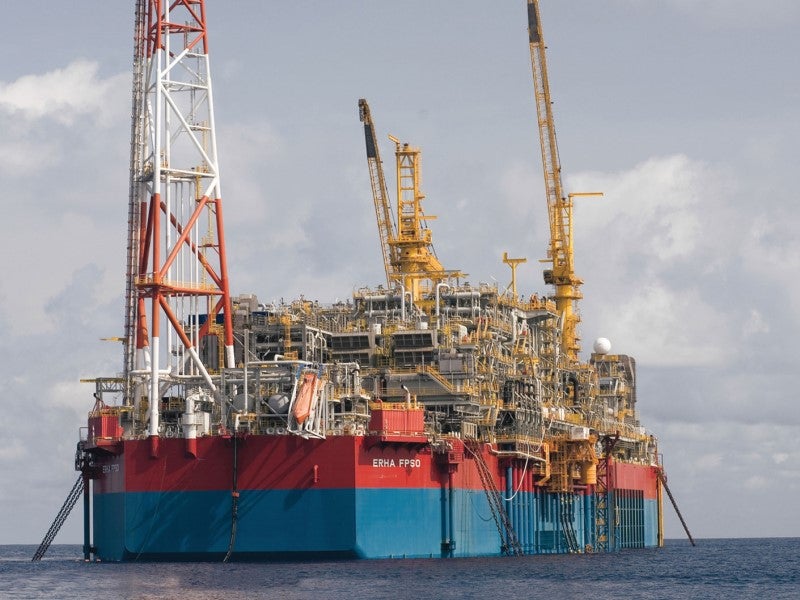The Erha deepwater development, including the Erha field and Erha North satellite field, was completed in 2006.
The fields are located approximately 97km offshore Nigeria, in water depths ranging from 1,000m to 1,200m. They were developed with an investment of $3.5bn.
Production from the main field started in April 2006, while production from the satellite field started in the third quarter of 2006. The production capacity from the development prior to the expansion was 140,000 barrels a day.
Completed in September 2015, the Erha North Phase Two development project is located at a water depth of 1,200m, approximately 96.5km offshore Nigeria. It is an extension of the existing Erha North subsea system and infrastructure. The final investment decision for the project was made in early-2013.
The project involved the installation of associated subsea facilities, modifications to the existing floating production, storage and offloading (FPSO) unit, and further development of the Erha North field by drilling wells from a new drilling centre. The Erha fields are located in Oil Mining Lease (OML) 133, which was formerly Oil Prospecting Lease (OPL) 209.
Esso Exploration and Production Nigeria (EEPNL) is the operator, holding a 56.25% participating interest in the OML 133 contract area, while Shell Nigeria Exploration and Production Company (SNEPCO) holds the remaining 43.75% share.
Discovery and reserves of the Erha offshore field
The Erha discovery was made in December 1999. Three appraisal wells were subsequently drilled, and two wells confirmed the presence of oil in Miocene turbidite sands.
The two fields are estimated to hold combined recoverable oil reserves of approximately 500 million barrels.
Erha deepwater development project details
The Erha deepwater development was the first deepwater offshore field in Nigeria. Three drill centres, comprised of 30 subsea wells, are tied back to the Erha FPSO vessel.
The drill centre east (DCE) and drill centre west (DCW) are located 1.5km from the FPSO, while the drill centre north (DCN) is located 8km from the other two drill centres and is tied back to DCE.
Processed oil from the project is stored in the FPSO and conveyed through two 16in diameter floating hose strings to offloading tankers moored to a catenary anchor leg mooring (CALM) offloading buoy, which is located 1.85km away from the starboard quarter of the FPSO.
Erha FPSO (Erha terminal) details
The Erha terminal is located within the Gulf of Guinea, offshore Nigeria at approximately 157.4km south-east of Lagos Port. The spread-moored Erha FPSO has a designed storage capacity of 2.2 million barrels of crude oil, and its designed oil processing capacity is 210,000 barrels per day (bpd). The FPSO’s water injection capacity is 150,000bpd, while its gas injection capacity is 340 million standard cubic feet per day (Mscfd).
The FPSO is 285m long, 63m wide and has accommodation facilities for 100 people. It is designed to operate for 25 years and is also equipped with a helideck.
Contractors involved with Erha North Phase Two
An engineering, procurement, construction and installation (EPCI) contract for the project’s subsea umbilical, risers and flowline (SURF) facilities as well as EPCI contract for new facilities on FPSO’s topsides was awarded to Subsea 7.
The company employed its Seven Borealis, Seven Pacific and Simar Esperança vessels for the project.
Subsea 7 subcontracted Trelleborg to supply its Vikotherm S1 silicone thermal insulation solution for the project’s oil and gas flowlines. Detailed engineering for the modifications to the FPSO and field’s subsea system as part of the project were performed by Technip’s affiliate, Crestech.
Subsea production systems comprised of five subsea production trees, two water injection trees, three manifolds, production and topside controls, and associated equipment were supplied by Cameron Offshore Systems Nigeria.
The company further subcontracted Aveon Offshore to perform the fabrication and load-out of these subsea production systems.
Seadrill was awarded a $497m contract to provide its West Saturn drillship for operations at the project site for a period of two years, which is extendable by one year.
West African Ventures was contracted to install certain manifolds and provide a DP3 accommodation vessel as well as ancillary marine support vessels for the project.
In March 2013, Aker Solutions was awarded the contract to supply the umbilicals for the project. Comprised of two dynamic and two static steel tube umbilicals, they cover a total length of 16.5km.
Other key players involved
Engineering, procurement and construction (EPC) contractors for the FPSO, tieback systems and subsea system were Saipem, Acergy Services, and Cameron International, respectively. The FPSO was towed to the project site by Giant Marine.
Saipem subcontracted Malaysia Shipyard and Engineering (MSE) and Sembawang Marine Offshore Engineering (SMOE, Sembcorp Marine) for the fabrication, integration, pre-commissioning and commissioning of the FPSO’s topsides modules.
The hull, living quarters and helideck of the FPSO were constructed by Hyundai Heavy Industries.
SMOE further subcontracted MMC Oil & Gas Engineering (O&G) to provide the detailed structural engineering and design for the electrical and instrument (E&I) modules of the FPSO. The CALM buoy was constructed by SBM Offshore.
Maersk Supply Service installed all Xmas trees for the Erha development project in 2005. More than 30 Xmas trees, each weighing up to 45t were installed for the project.











